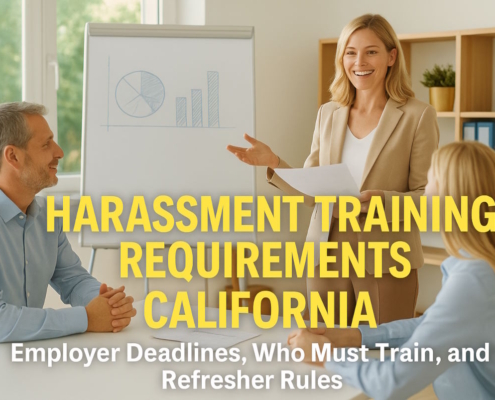Introduction
Many owners of companies have realized that there are serious consequences associated with hiring or paying employees incorrectly in California. The integrity of worker wage payments has long been protected, even going back around 40 years before the Fair Labor Standards Act (federal) of 1930. There is no indication that California will change its course. Indeed, Labor Code 2810.5, also known as “Section 2810.5,” went into effect on 1st January 2012, which was around nine years ago. Assembly Bill 469 of 2011, also referred to as the “Wage Theft Protection Act,” included Section 2810.5.
Even though the majority of employers do not purposefully steal wages, and the Act’s name offends many truthful employers, it does highlight one point: Just like any other mistake on your federal or state tax return, even a small mistake when setting and paying an employee’s wages can result in serious penalties.
Why it can be expensive not to follow Labor Code Section 2810.5
The number of audits conducted by the California Employment Development Department and the US Department of Labor is notably increasing. Employers who fail to comply with fundamental state and federal minimum wages & overtime requirements have found these agency audits to be painful. The worst-case situation, though, is when a disgruntled worker hires a lawyer to fight not just their personal complaint but also other workers’ claims. The California Private Attorney General Act (henceforth, “PAGA”) is usually used for this.
Employers who fail to pay their employees in accordance with the California Labor Code, as well as the California Wage & Hour Order relevant to the occupation or industry governed by the Wage Order, may be subject to significant civil penalties for their clients along with the State of California under the regulations of PAGA. Even worse, if employees are bound by the same policy that results in the breach, a class action lawsuit may be filed.
The Hiring Checklist
- Determine which wage & hour order is relevant to your company
California uses five occupational orders in cases where the industry code is not appropriate, and twelve “industry” orders depending on the sort of business being undertaken. Therefore, an employer should ascertain which Wage and Hour Order applies to the occupation or their business that the new worker will be required to fill, ideally with the assistance of an experienced labor lawyer. The Industrial Relations Department (California) publishes a great resource to help a potential employer decide which Wage and Hour Order fits.
- Employers Must Adhere to Section 2810.5’s Criteria
According to further amendments, Labor Code Section 2810.5 requires “an employer” to give “each worker a notification (written) in the format that the company typically uses to convey employment-related details to the employee.” This includes the following:
- The rate or rates of compensation and the justification for them, including any relevant overtime rates, whether they are paid per hour, day, shift, week, piece, salary, commission, or another method.
- Any benefits, such as food or housing allowances, that are sought as a component of the minimum wage.
- The regular paycheck that the company designates in compliance with this code’s provisions
- The employer’s name, together with any possible “conducting business as” identities they may have utilized.
- The physical location of the employer’s major place of operation or main office, together with a mailing address if applicable.
- The employer’s telephone number.
- The company’s workers’ compensation insurance provider’s name, address, and phone number.
- A worker has the following rights: the ability to request and utilize paid sick leave; the protection against termination or retaliation for using or asking for sick leave; and the ability to submit a grievance against a company that retaliates.
- Any additional information that the Labor Commissioner determines is important and required.
- The California Form should be used for Labor Code Section 2810.5
Fortunately, the Act also requires the California Labor Commissioner to “provide a standard template that complies with [the aforementioned] standards” and give employers access to that template. Yes, that template is available on the website of the California Department of Industrial Relations.
Although many of the conditions outlined in Labor Code Section 2810.5 can be addressed by an employer using an offer letter, we strongly advise using the form to ensure that the information necessary according to Section 2810.5 isn’t unintentionally left out. Get a skilled employment law attorney to assess any offer letters or other unique correspondence you utilize to meet Labor Code Section 2810.5 standards.
- Meeting Section 2810.5’s Preliminary Requirements
Let’s dissect Section 2810.5’s two initial requirements. It’s crucial to remember that firms outside of California are also covered. “An employer” is used in Subsection (a) (1). Therefore, any employer who hires a California resident will most likely be subject to Section 2810.5’s requirements, regardless of where they are located.
Second, the employer is required by Section 2810.5’s language requirement to correspond with the employee. The language should be the one that they use for all employment-related communications. The terms of Section 2810.5 must therefore be translated into the new employee’s native tongue and made available to them, whether the employer speaks to them in Spanish, Mandarin, or another language. Section 2810.5 has been conveniently translated into 6 languages by the Department of Labor Standards and Enforcement. The copies of these translations are available for free download on the DLSE website.
- Wage Setting: The California Minimum Wage That Applies
Section 2810.5 mandates that the employer include the hourly rate or rates that apply to the employee on the form. Probably, this is the hardest part of adhering to Section 2810.5. Although there are some particular restrictions, keep in mind that practically all employees are required to receive the higher of the California or municipal minimum wage rather than the minimum wage set by the federal government, which is perpetually lower.
Additionally, while there may be several wages—for instance, a standard rate for actual work—there may also be a second, usually lower wage for additional responsibilities, like traveling time. The rate must not be less than the relevant minimum wage, notwithstanding. For companies with 25 or fewer workers, the minimum hourly pay in California is different than that for companies with 26 or more workers. The DIR publishes a chart showing the hourly minimum wage.
By passing local ordinances, a few California counties and localities have raised the minimum wage. The University of California (Berkeley Labor Law Center) is a useful resource for figuring out whether such a local statute supersedes the California minimum wage.
Remember that you must compensate that position twice the applicable yearly minimum wage when determining an exempt employee’s salary since their primary responsibility satisfies the Wage and Hour Order’s requirements for a supervisory, administrative, or professional exemption.
Special regulations and analysis are needed to ensure that the Labor Code and appropriate Wage & Hour Order are not broken if your employee is paid exclusively on a commission or piece-rate basis, or if they are employed pursuant to the “outside salesman” exemption. Employ and speak with a knowledgeable lawyer. Avoid doing it alone! You are very likely to hire an employee’s lawyer as well!
- Sick leave, allowances, and other clauses
Employers in California may be able to receive credits toward the minimum wage for offering meals and accommodation for their staff, but this should also be thoroughly examined by a knowledgeable lawyer. In a similar vein, before employing their first worker, the company should have legal counsel assess and consent to their sick leave policy.
In conclusion
Labor Code Section 2810.5 acts as the checklist for adhering to the particular legal restrictions placed on firms that want to keep workers in California, even though you must recruit an employee in complete accordance with federal laws. Individuals must be correctly classified and given employment possibilities after careful study of numerous laws. Finding a skilled, knowledgeable California employment law lawyer is usually necessary to get it properly. If it’s done incorrectly, the employer may believe that they paid more than they could have imagined for the worker and the worker’s attorney.































